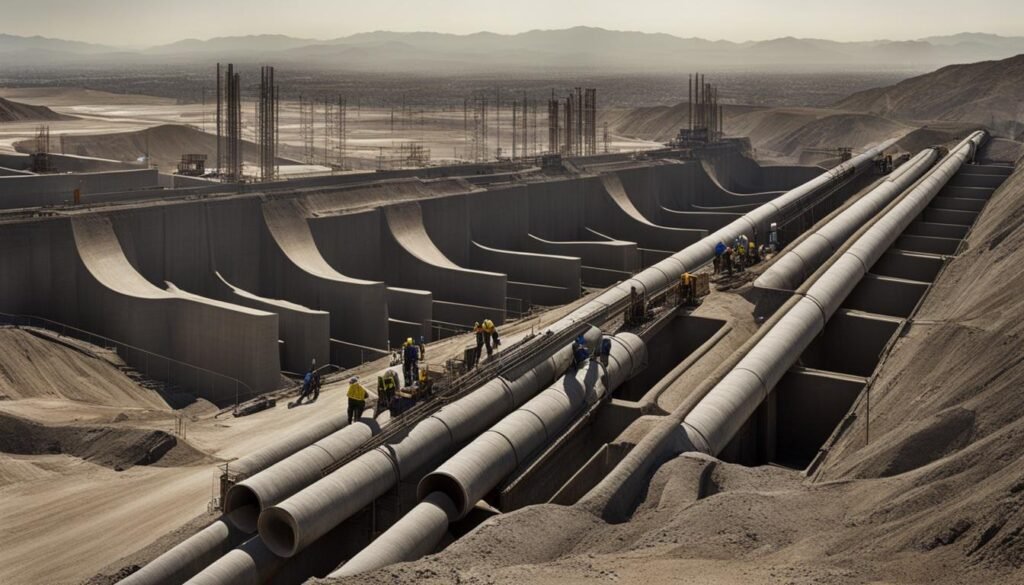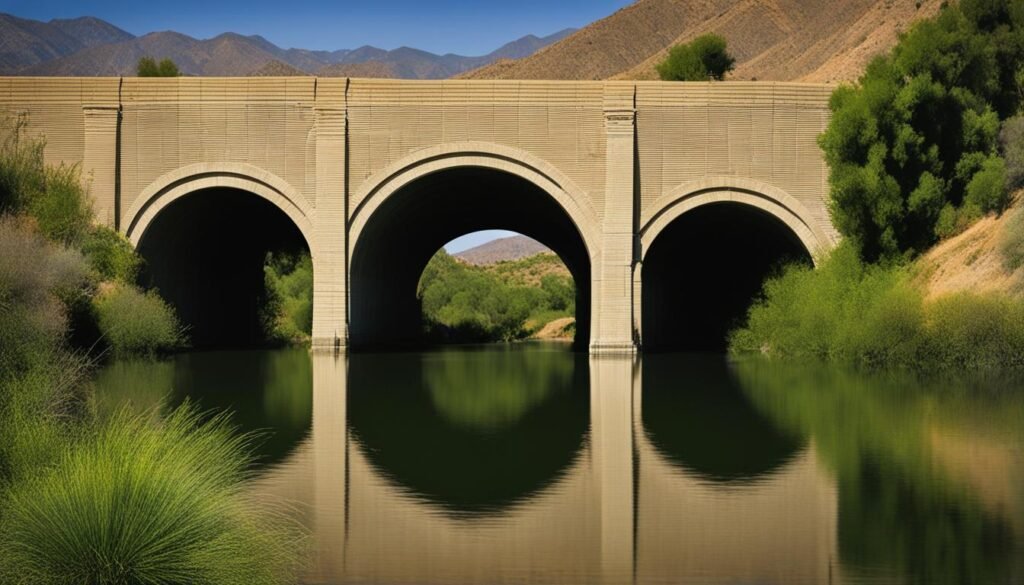The Los Angeles Aqueduct holds a significant place in the history and infrastructure of California. Built in 1913, it stands as a remarkable engineering marvel that ensured a reliable water supply for the growing population of Los Angeles. This aqueduct system, spanning 233 miles, brought water from the Owens River to the bustling city, supporting irrigation, industrial use, and residential consumption.
The Los Angeles Aqueduct project was spearheaded by pioneering figures such as William Mulholland, Frederick Eaton, and J.B. Lippincott. Their foresight and determination led to the successful completion of this monumental venture.
Throughout its construction, the aqueduct faced opposition and controversy, particularly from the agricultural community in the Owens Valley. However, its impact cannot be denied. It played a pivotal role in transforming Los Angeles into a major urban center and supported the city’s growth in agriculture, industry, and residential development.
Key Takeaways:
- The Los Angeles Aqueduct was completed in 1913 and brought water from the Owens River to support Los Angeles’ water needs.
- It played a crucial role in the development and growth of the city, providing water for irrigation, industry, and residential consumption.
- The aqueduct system spans a total distance of 233 miles and consists of storage reservoirs, tunnels, siphons, and conduits.
- Controversies arose due to the diversion of water from the Owens River, leading to conflicts with the agricultural community in the Owens Valley.
- The aqueduct remains an essential part of Los Angeles’ water infrastructure and contributes to managing droughts and water scarcity in the region.
Construction of the Los Angeles Aqueduct
The construction of the Los Angeles Aqueduct commenced in 1905 and was successfully completed in 1913. This ambitious project involved acquiring land along the Owens River in Inyo County and developing a comprehensive system to transport water to Los Angeles. Built to ensure a reliable water supply for the growing city, the aqueduct spans a distance of 233 miles and consists of tunnels, conduits, and siphons that allow water to flow by gravity.
The construction process was no small feat. It required the construction of storage reservoirs, the laying of pipelines, and the development of roads and rail lines to transport construction materials. The project faced some controversy and opposition, particularly from the agricultural community in the Owens Valley. The diversion of water from the Owens River to Los Angeles resulted in the drying up of Owens Lake, exacerbating tensions and environmental concerns.
Despite the challenges, the California Aqueduct System stands as a testament to the ingenuity and determination of the visionaries who led the Los Angeles Aqueduct project. This remarkable engineering accomplishment has played a pivotal role in shaping the city’s growth and development. Let’s further explore the impact of the Los Angeles Aqueduct in the subsequent sections of this article.

Impact of the Los Angeles Aqueduct
The completion of the Los Angeles Aqueduct had a profound impact on the city. It provided a stable water supply that allowed for the continued growth and development of Los Angeles.
The aqueduct played a crucial role in the expansion of agriculture, industry, and residential areas in the region. It helped transform Los Angeles into a major urban center and supported its population growth.
The Los Angeles Aqueduct infrastructure enabled the city to effectively manage droughts and water scarcity. It facilitated better water management and conservation efforts, ensuring that the city had enough water to meet its needs even during dry periods.
Benefits of the Los Angeles Aqueduct:
- Stable and reliable water supply
- Support for agricultural and industrial growth
- Expansion of residential areas
- Transformation of Los Angeles into a major urban center
- Effective drought management and water conservation
The Los Angeles Aqueduct remains a fundamental component of the city’s water management system and has played a significant role in shaping its history. The aqueduct’s infrastructure and management efforts continue to ensure a sustainable water supply for the city.

Controversies and Legacy of the Los Angeles Aqueduct
The construction and operation of the Los Angeles Aqueduct were not without controversies. The diversion of water from the Owens River to Los Angeles led to conflicts with the agricultural community in the Owens Valley, who relied on the water for their livelihoods. The drying up of Owens Lake also had environmental consequences.
Despite the controversies, the legacy of the Los Angeles Aqueduct is both complex and significant. Its construction played a pivotal role in the development and growth of Los Angeles, helping establish the city as a major global metropolis. The aqueduct system, with its extensive route spanning California, provided a vital water supply for the city.
Today, the Los Angeles Aqueduct remains an essential part of the city’s water infrastructure. Efforts are ongoing to manage and sustain the water resources in the region, ensuring a reliable water supply for the ever-growing population of Los Angeles. The aqueduct’s historical importance and its contribution to the city’s water supply make it a symbol of resilience and forward-thinking water management.
As a result of the aqueduct’s success, it has also paved the way for other water transfer projects across California. The aqueduct serves as a prime example of how a large-scale project can overcome significant challenges and provide water security to a growing urban area.
Conclusion
The Los Angeles Aqueduct is much more than a historic engineering marvel; it is the lifeline that sustains the diverse needs of Los Angeles. This incredible system, completed in 1913, has provided a consistent and plentiful water supply for the city, supporting its agricultural, industrial, and residential sectors.
Despite the controversies and challenges that have arisen in its wake, the Los Angeles Aqueduct has remained a testament to the ingenuity and vision of its creators. From the resilient engineers to the forward-thinking leaders who spearheaded the project, this system stands as a symbol of the city’s ability to adapt and thrive.
The importance of the Los Angeles Aqueduct cannot be overstated. It continues to play an indispensable role in meeting the water demands of the bustling metropolis. As other regions struggle with water scarcity, Los Angeles enjoys the benefits of a reliable and sustainable water supply, thanks to the aqueduct system.
The Los Angeles Aqueduct is more than just a network of pipes and reservoirs; it is an embodiment of Los Angeles’ resilience, ingenuity, and commitment to sustainable growth. As the city continues to evolve, this historic infrastructure will remain an integral part of its identity, ensuring that the needs of its residents and industries are met for generations to come.
FAQ
When was the Los Angeles Aqueduct built?
The construction of the Los Angeles Aqueduct began in 1905 and was completed in 1913.
What is the purpose of the Los Angeles Aqueduct?
The Los Angeles Aqueduct was built to provide a reliable water supply for the growing population of Los Angeles, supporting agriculture, industry, and residential consumption.
How long is the Los Angeles Aqueduct?
The Los Angeles Aqueduct spans a total distance of 233 miles.
Who built the Los Angeles Aqueduct?
The project was spearheaded by William Mulholland and supported by Frederick Eaton and J.B. Lippincott.
What impact did the Los Angeles Aqueduct have on the city?
The completion of the Los Angeles Aqueduct played a crucial role in the expansion and development of Los Angeles, transforming it into a major urban center and supporting its population growth.
Was there any controversy surrounding the Los Angeles Aqueduct?
Yes, the diversion of water from the Owens River to Los Angeles led to conflicts with the agricultural community in the Owens Valley, and the drying up of Owens Lake had environmental consequences.
What is the legacy of the Los Angeles Aqueduct?
The Los Angeles Aqueduct remains an essential part of the city’s water infrastructure and symbolizes its ability to overcome water scarcity and thrive. It continues to provide a stable water supply and supports water management and conservation efforts in the region.







